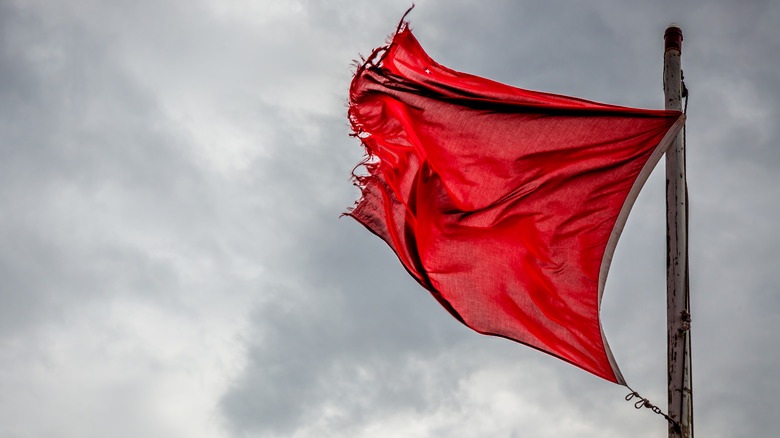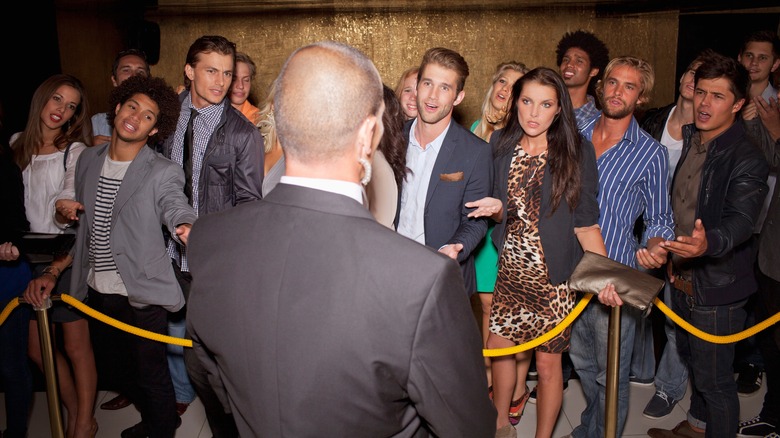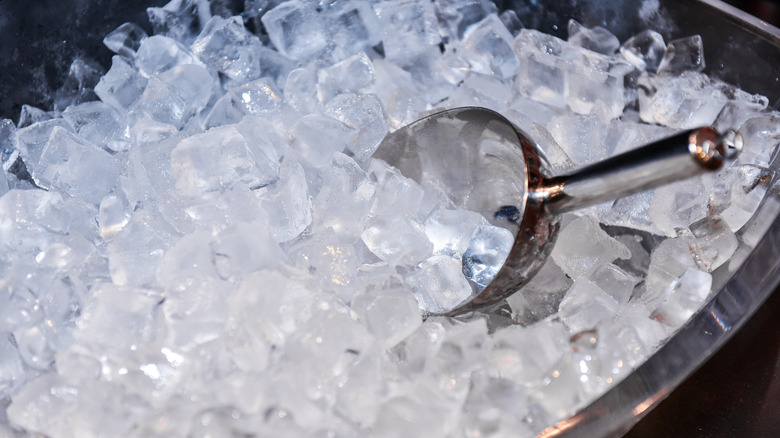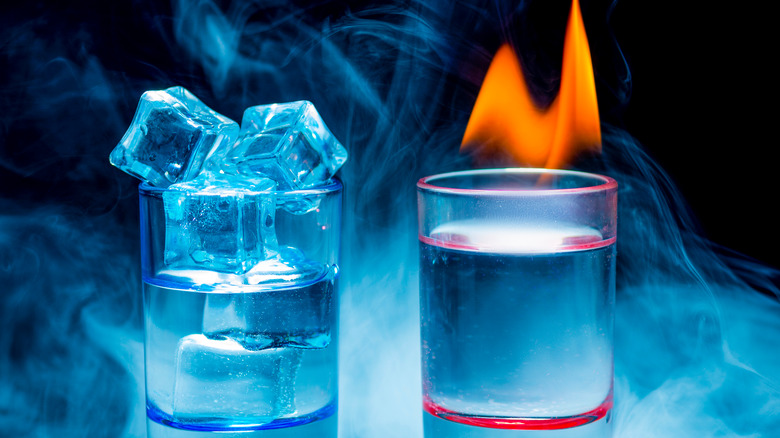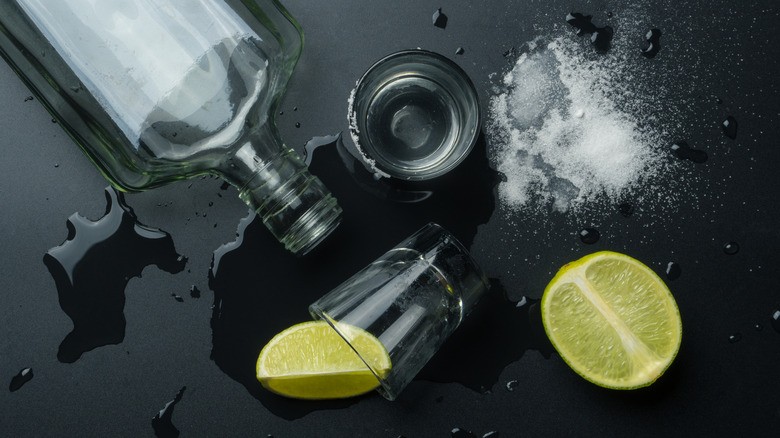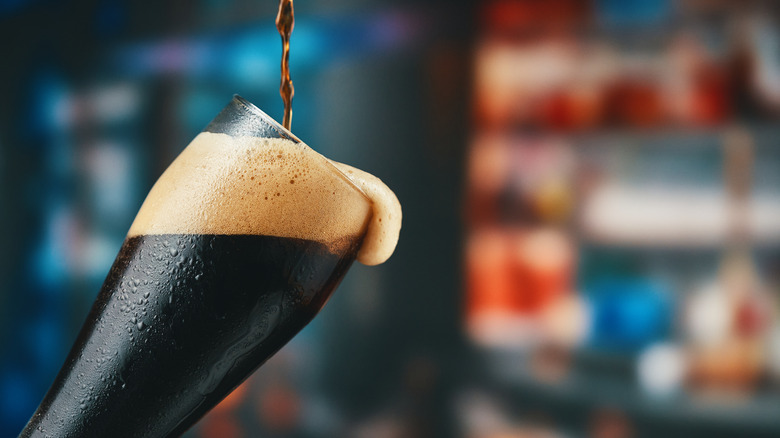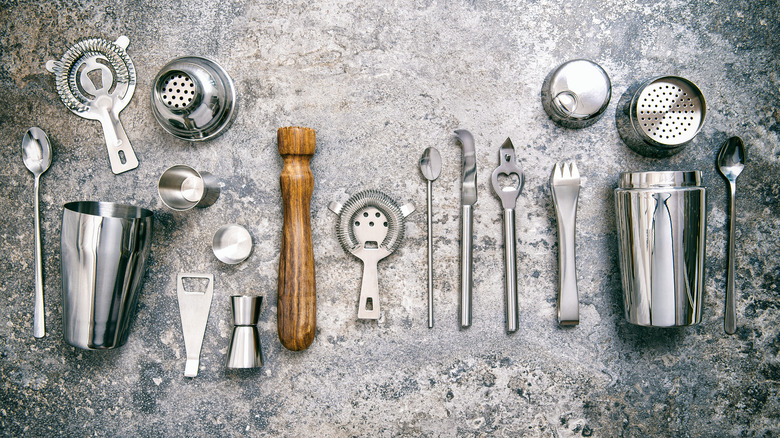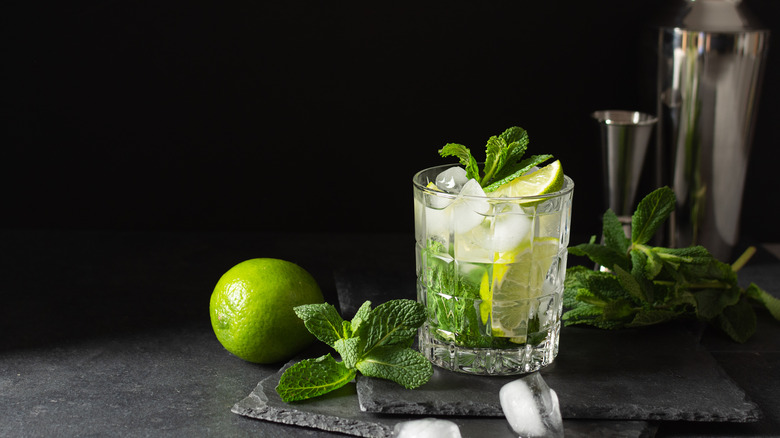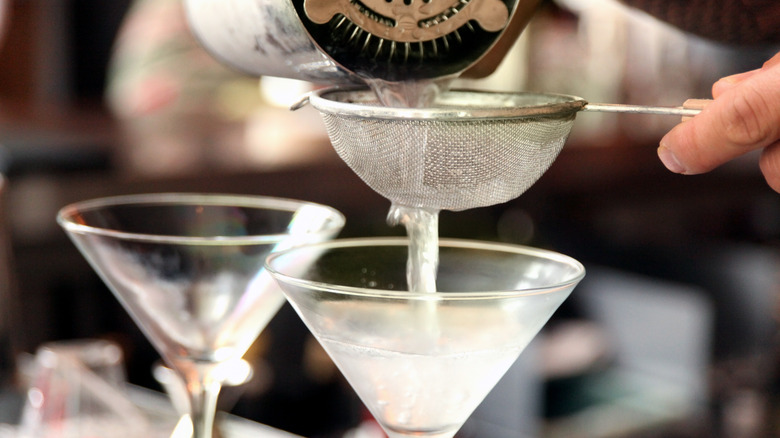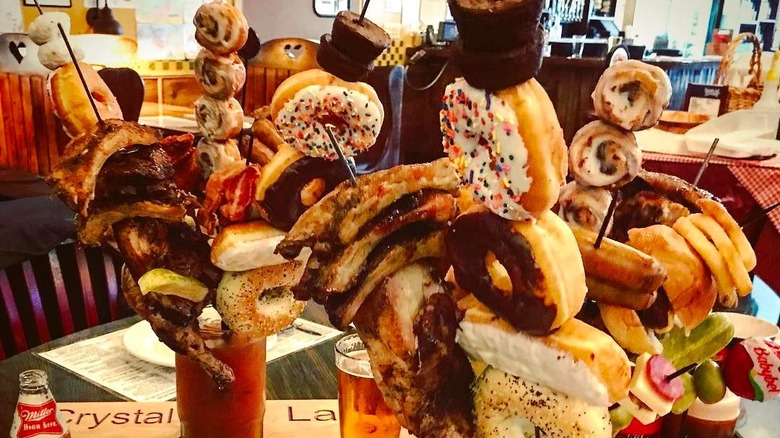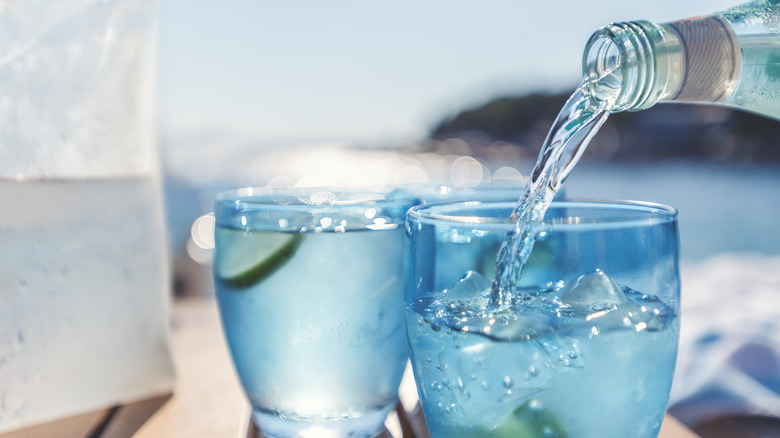11 Red Flags You Should Look Out For When Drinking At A Cocktail Bar
If you're looking for a new bar to try, how do you know if a place is worth your time or money? A good way to evaluate your new (or old) haunt is to have a list of red flags that could be game-changers as to how much time, if any, you want to spend there. While there are some glaringly obvious signs that you should turn and leave, other red flags are more subtle if you don't know what you're looking out for. Plus, some red flags are purely personal preferences and not necessarily problematic, however, others can alert you to potentially dangerous situations.
But, while navigating the plethora of bars on offer to you in any given town, how do you know which red flags are the most important ones to take note of? Well, thankfully for you we've compiled a list of the top 11 red flags you should watch out for when drinking at a cocktail bar.
Crowd control
One of the easiest methods to find out about a bar's connection to its clientele is to check its social media presence. However, local bars or clubs may not have a strong online presence which isn't necessarily an issue. But, one of the biggest red flags regarding a bar is how the management responds to customers.
You can easily track their responses (if they respond at all) through social media. And, zero social presence with regard to customer complaints could equal a red flag. We've seen it: dirty restrooms, sticky dance floors, and dangerous outdoor patio floorings — all red flags. If you're seeing grievances about these or anything else, and customers are being ignored, that's an indication you might want to choose another cocktail bar. And, in the brave new world of social media, a blatant disregard for customers' requests can certainly turn people away.
Ever see long lines outside a non-descript club and think "I should be in there!"? Well, think again, because long waits can be a red flag. While being part of a long line to a trendy bar may make us feel we're part of something that's sought after, it can often translate to a frustrating experience. After all that time waiting to get in, you now have to wait in a big crowd inside the bar, just to get service! And, given Americans already spend approximately 37 billion hours in lines every year, why add more?
Ice Ice Baby
Once you've made it into the bar, one of the easiest red flags to spot is your bartender scooping ice with a glass, or worse, their bare hands. If your bartender uses anything other than an ice scoop or tongs, this should set off warning alarms. A bartender using a glass to scoop up ice is a bad practice as they should be using a scoop or tongs, but never a glass, and absolutely never their bare hands. If you see a bartender using their bare hands to scoop ice, don't accept the drink.
So, what's the problem? There are actually several issues. When a glass is scooped through ice cubes, the glass can break or chip. Broken glass means the entire freezer is a safety issue that may not be discovered until a customer is harmed from ingesting glass. A bartender may feel scooping ice with a glass is saving a few seconds of time, or that it's less hassle than dealing with tongs or a scoop. What they are actually demonstrating is a lack of care or awareness for the safety of their customers. Ice is a food item, but unlike many foods, it cannot be cooked. During the normal cooking process of food, many contaminants will be eradicated, but ice will retain any bacteria living on it.
Too hot to handle
Have you ever grabbed a hot glass right out of the dishwasher and then poured ice or a cold drink? We admit we've done this at home, knowing it's a bad idea and we understand bartenders can be busy, but pouring a cold drink into a hot glass is a red flag, who wants a cold beer that's warming up much faster than it should? Also, putting ice into a hot glass means the ice starts to melt faster, diluting your drink and therefore not being served at its best.
But also, using a hot glass for a cold drink can cause the glass to break or even totally shatter. Professor of materials science and engineering, John C. Mauro, Ph.D. explains putting a hot beverage into a container that's not specifically engineered for high temperatures can cause thermal shock, which is when temperatures change rapidly in a substance. So, when a hot glass has cold water poured onto it the inner layer of the glass will expand while the outer layer remains cooler, causing tension in the material and forcing it to break.
Bad bartender
While your bartender may not be happy when you rock up and order a cosmopolitan the Carrie Bradshaw way, how they act towards customers can be a red flag. If the bartenders are ignoring you to chat with other customers, chatting up the hotties, or with other staff, you have a rude bartender. While you shouldn't expect your bartender to become your new best friend, good customer service means being attentive and polite.
Notice how the bartenders act towards each other, not just customers. Do the bartenders and staff seem unhappy or overworked? Are they rude to other employees? If the bar staff appears weary or distracted, this can be emblematic of bigger issues. It can indicate understaffing issues, overworked employees, or much larger problems relating to the ownership of the establishment. Nevertheless, these concerns translate to bad customer service or lapses in upkeep like sanitation and quality, and you as the customer certainly don't want to be at the wrong end of that.
Sticky situation
When going into an establishment, a huge red flag is dirty glasses or serving ware left out even though the venue isn't busy. When a place is busy, it's forgivable, as staff won't get every dirty glass as fast as they may like. But, when a bar isn't busy, that is the time it should be at its cleanliest, or at least getting cleaned. Ask yourself, if the dining area looks this bad with no customers, what is going on in the kitchen or behind the bar? Maybe it's better if you don't know!
If you've ever been to a bar with sticky wood surfaces, odds are pretty good you thought, "Ewww." However, a sticky surface doesn't necessarily translate to uncleanliness. Sometimes tacky wooden bar tops occur after not using the cleaner correctly, leaving a residue, or using the wrong cleaners. However, incorrect cleaning can indicate poorly trained or mismanaged staff.
And, if you're in a bar or a club with sticky floors or unattended spills, this is another alarming red flag. It's understandable if it's a busy night on a dance floor — things happen — but when those spills are not taken care of, they become a safety hazard for slips and falls. And, when a bar does not take the time to clean the floor, this can be a further indicator of overworked, or uncaring staff. Nevertheless, we all hate when our shoes get tacky on the bottom and make that weird, squishy noise. So, best avoid!
Foam Dome
Even at a cocktail bar, a nice foamy head on a beer looks great ... or does it? There are various foam heads for different beers. Knowing the difference will help you spot potential red flags, and not make a fool out of yourself for yelling at your bartender because you didn't want a head on your beer.
A good bartender knows that a 45-degree angle and the right glass for different brews result in a perfect foam head on your beer. Although it may look like all that foam is taking up precious space for your beverage, foam and a good pour can make or break a brew. Not having a foam head on your beer is actually the red flag.
Not allowing a foam head keeps the brew's carbon dioxide from releasing, resulting in the dreaded "beer bloat." Now you've got a bloated belly and risk a huge beer belch right when you're trying to say something clever to the hottie next to you.
It's all in the technique
Our next red flag may be contentious depending on your bartender and venue. In some establishments, bartenders may free pour, meaning they aren't using visible measuring tools like jiggers or cocktail pourers in their bottles. These may not be red flags because your bartender is likely counting "one, one thousand, two..." as they pour. This is mostly acceptable and is likely part of the ethos or culture of the bar. But, free pouring can also result in inconsistent drinks if not done correctly.
However, just because your bartender is using a jigger to make your drink doesn't equate to a well-made drink. Bartenders who slosh the alcohol from jigger to drink are nobody's friend. Not only should a jigger be poured with care, but sloppy use of it means an inconsistent measure. Now the bar mat is getting a taste of your drink, meaning you're not.
Also, when a bartender holds a jigger over the glass or shaker as they pour the liquor, accidental mistakes can fall into the drink, resulting in a mismeasurement and unbalanced cocktail. Plus, a messy jigger pour can cost the bar more money, potentially resulting in higher costs for everyone — including you, the customer.
Is your bartender muddled?
If you're at a cocktail bar, you should be safe to assume mojitos will be well made. Unfortunately, mojitos can also be full of red flags, especially if you're at a dive bar, nightclub, or other non-cocktail establishments. A bartender who over-muddles the mint has now created a muddy, bitter-flavored beverage and all those minty bits will get stuck in your teeth. That's not a good look when you're trying to flirt. Eww.
Be warned though! Although mojitos are a lovely, crisp, minty fresh delight, your bartender may not like you for ordering one. Even in a cocktail bar, mojitos aren't a favorite for bartenders to make because the drink is time-consuming to prepare correctly. So, if you ask for a mojito during a busy night it will not win you any favors.
A well-made mojito takes time and a lot of effort to make; the mint must be muddled correctly, mojitos are sticky because of the simple syrup, and keeping the mint fresh for some bars can be a problem. Bartenders also fear the "mojito effect." This is when one person sees a mojito and says, "Oh, that looks refreshing! I want one too!" Now your poor bartender is muddling away, muttering under their breath, "Why didn't I just say we're out of mint?"
When your drink is incorrectly made or served
You've decided to be a polite patron and not order a mojito at your favorite, but busy cocktail bar. One of the most classic cocktails is an Old-Fashioned. If your bartender doesn't know how to make one, that's a massive red flag. And, all those bottles displayed across the back of a bar may be a beautiful sight, but it can also be a red flag. A huge selection of drinks may indicate the establishment is sacrificing quality for quantity.
Many drinks need to use spirits that are kept cold like a negroni or martini. If the bartender grabs a bottle of vermouth or Campari off the shelf or from the unrefrigerated portion of the well and starts making your drink, the drink has been made improperly. Using unrefrigerated vermouth is another red flag as this spirit should be kept chilled. Other drinks which should be kept cold include coffee liqueurs such as Kahluah and Jägermeister.
Ordering a cocktail can be daunting if you don't know about the various types of drinks and preparation methods. For example, James Bond's iconic martini order, "shaken, not stirred," but for traditionists, a martini should be stirred, never shaken. Making the drink this way results in a more diluted cocktail it also clouds the gin, so both these results are not optimal for martinis. Margaritas or other citrus-based drinks, on the other hand, should definitely be shaken and not stirred.
Ridiculous garnishes
Julia Robert's film "Pretty Woman" shows a financially strapped character using the garnishes at a local bar like a buffet. While this may seem cute in the movie, it's a huge problem. Firstly, the garnishes aren't a buffet, and secondly, this can be a health concern. If customers graze the garnishes, that means potentially unwashed hands are touching the food. If your bartender is grabbing garnishes with their bare hands, they may be causing cross-contamination. While some states allow bare-handed contact for some garnishes (per AFDO), a knowledgeable, considerate bartender should still use tongs or a toothpick when possible.
The correct garnish isn't just about being pretty (although that can be nice) but can heighten the flavors and aromas of the drink. While some garnishes can enhance the drink, they can often go way too far.
A recent cocktail trend was to make over-the-top Bloody Marys. Some of the bars feature turkey legs, skewered slices of pizza, chicken wings, sliders, or a host of fried foods like fried okra, Scotch eggs, or entire smoked fish all crammed atop the drink. We're not saying this is a red flag, but it does question whether the drink is good or is it all style, with little substance.
Hydration is key
Drinking water is a tip to help stave off either getting drunk or to prevent a hangover but for some bars, this is an issue. While drinking water to prevent hangovers has actually been debunked, according to the BBC, drinking water at a bar is still a good idea. And, you could consider jazzing it up by ordering something else like a soda water! Drinking water while at bar or almost anytime will help minimize headaches — alcohol is a dehydrator after all.
Whatever your reasons for requesting ice water are, it is a serious red flag if your bartender refuses. In some states, refusal to give water is against the law. In Austin, Texas it is punishable with a fine to not serve water upon request. It stands to reason as the person requesting water may be a designated driver or need it for other personal reasons.
Aside from all the legalities, not serving water is plain and simply just lousy customer service. The reverse, however can actually really improve a customer's experience. In fact, Kyle Law, of Alley Cat Lounge in Savannah, Georgia, says serving ice water before a customer orders "takes away the self-imposed feeling of having to make a decision quickly," thus allowing customers to relax while making their selections (via Liquor.com).

